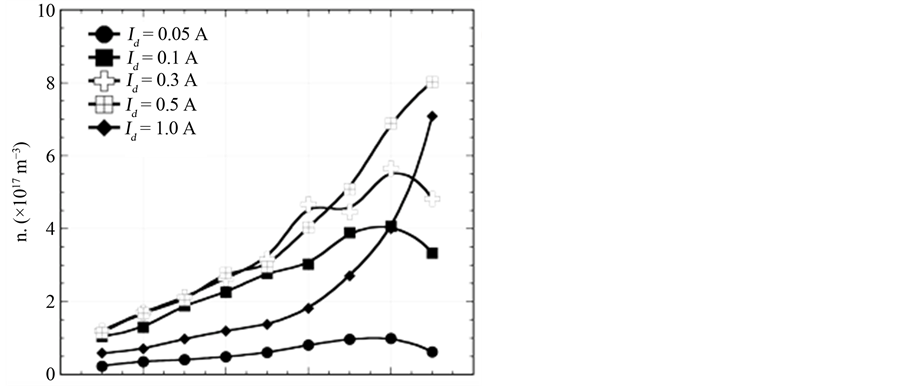High Density Fluorine Negative-Ion Source Generated by Utilizing Magnetized SF6 ()
Keywords:Fluorine Negative-Ion; Ion Source; String-Type Plasma; Radial Diffusion; Langmuir Probe; Magnetized Plasma; Sulfur Hexafluoride
1. Introduction
It is already known that negative-ions can be produced by magnetized plasmas, in which discharge of electronegative gas such as CF4 gas makes fluorine negative-ions and they accumulate around a magnetized plasma column via radial diffusion [1-4]. Higher-density and stable fluorine negative-ion sources have potential to make fine silicon etching, because the negative-ions could reduce the charging-up damage and abnormal etching on the etching surfaces in case of LSI fabrications [5-10].
In this study, in order to obtain higher density fluorine negative-ions, on the standpoint of future application to negative-ion etching, SF6 is used as a source gas of the magnetized plasma because this gas has high electron affinity, particularly at low electron temperatures [11]. The pressure and discharge current dependences of negative-ion density are also studied.
Though multiple negative-ion species (F−,  ,
, ) may have contributed to negative charges around the SF6 plasma column via nondissociative attachment and dissociative attachment reaction schemes, F− ions have the highest density [12], similarly to the case of CF4 plasmas [13].
) may have contributed to negative charges around the SF6 plasma column via nondissociative attachment and dissociative attachment reaction schemes, F− ions have the highest density [12], similarly to the case of CF4 plasmas [13].
2. Experimental Setup
Figure 1 shows a schematic diagram of the experimental setup. A metal chamber of 2.0 m length and 21 cm diameter is set across eight solenoid coils producing a magnetic field of 0 - 0.15 T. An electron beam of 20 mm diameter is injected by an electron-beam source (placed at the axial center about 85 cm from the chamber end), which has a beam energy of ΨBE = 100 eV and a current of IBE = 0 - 1.0 A. The anode of the beam source (20 cm in diameter), which has a gridded hole of 20 mm diameter on the center, is grounded. At about 77 cm from the anode, an electrically grounded metal end-plate of 20 cm diameter is placed. Hot-wire-type Langmuir probes made of Ta wire of 0.2 mm diameter, shaped as semicircle of 1.5 mm diameter, are used for the diagnosis of the plasma. Here, results are obtained using the probe placed at 25 cm from the end plate.
In the dc-discharge plasma, thermal electrons in the

Figure 1. Schematic diagram of the experimental setup.
SF6 plasma are produced by injecting an electron beam with an energy of 100 eV along the magnetic field. Some of the thermal electrons are lost at the end electrodes by diffusion along the magnetic field and by attachment to neutral molecules. On the other hand, the produced negative ions are well confined along the magnetic field by sheath potentials at the end plates, and are partially lost by recombination with positive ions. Around the column-type plasma, the radial-diffusion speeds of electrons and negative ions are very different, which can cause high negative-ion accumulation around the plasma column.
3. Results and Discussion
The negative-ion density in the SF6 plasma is evaluated from the probe measurement utilizing the modified Bohm condition [1,14]. At slightly outside the electronbeam region, negative ion density n− ≈ 8 × 1017 m−3 at r = 1.0 cm for the typical conditions of B = 0.030 T, p = 0.13 Pa, and Id = 0.50 A is obtained. Figure 2 shows radial profiles of n− evaluated using the modified Bohm condition across the plasma column. The results from the normal Bohm condition is also plotted for comparison.
Radial profiles of the negative-ion density, n− and electron density, ne are shown in Figure 3 under the typical conditions of B = 0.030 T, p = 0.13 Pa, and Id = 0.50 A. From this figure, it is evident that the density ratio of n− to ne monotonically increases with the increase in radial distance and it is more than 1000 at r > 3.0 cm.
Figure 4 shows radial profile of electron temperature Te. Te ≈ 1 eV outside the beam region and Te ≈ 2 eV within the electron-beam region are obtained. The produced SF6 plasma is a typical low-temperature plasma.
Radial profiles of n- across the magnetic field are measured for several discharge currents and pressures and are shown in Figure 5, where profiles of the discharge current dependence at p = 0.13 Pa (a) and the pressure dependence at Id = 0.30 A (b) are shown. From these figures, it can be understood that n- always has radial gradient. In these experiments, maximum value of

Figure 2. Radial profiles of n− across the plasma column evaluated by the two methods. B = 0.030 T, p = 0.13 Pa, and Id = 0.50 A.

Figure 3. Radial profiles of n− and ne evaluated using the modified Bohm criterion. B = 0.030 T, p = 0.13 Pa, and Id = 0.50 A.

Figure 4. Radial profile of Te across the plasma column. B = 0.030 T, p = 0.13 Pa, and Id = 0.50 A.
n− is 8.0 × 1017 m−3 at r = 1.0 cm, Id = 0.50 A and p = 0.13 Pa under B = 0.030 T.
The radial profiles of n- obtained in the present study for SF6 across the magnetic field are compared with those for CF4 obtained in earlier studies [1,11]. Both re-
 (a)
(a) (b)
(b)
Figure 5. Discharge current dependence at p = 0.13 Pa (a) and pressure dependence at Id = 0.30 A (b) of radial profiles of n−. B = 0.030 T.
sults have such a radial density gradient. Outside the electron-beam region, the negative-ion density for SF6 gas is on the order of 1017 m−3, whereas for CF4 gas it is on the order of ≈1016 m−3.
4. Conclusions
Radial profiles of negative-ion density across the magnetic field are measured in SF6 plasma under various experimental conditions, where the major ion species is F−. The modified Bohm condition is utilized for the calculation of n−. It is found that in the series of experiments, n− is maximum of 8.0 × 1017 m−3 at p = 0.15 Pa, r = 1.0 cm, and B = 0.030 T, which is larger than the results of CF4 gas.
The control of the radial density profile should be studied, and now it is under study by changing the magnetic field and other experimental conditions.
Acknowledgements
This study was supported by The True-Nano Project of Shizuoka University (2009) and JASSO Follow-up Research Fellowship (2010).